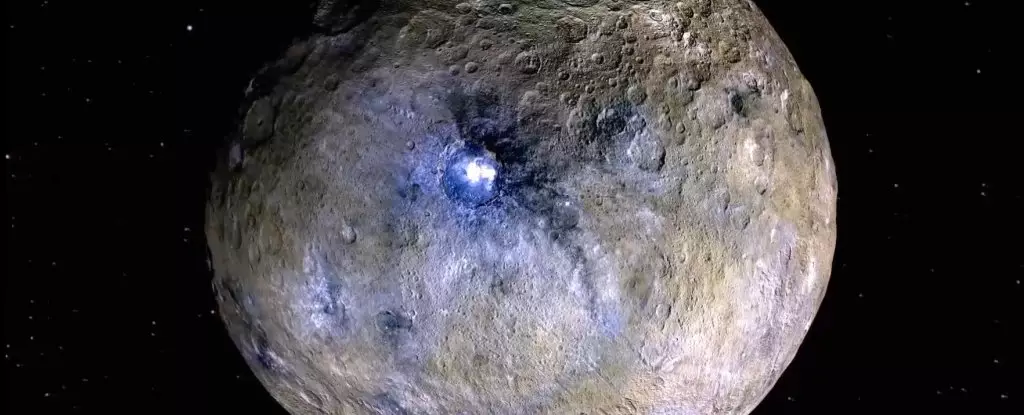In the vast expanse of our Solar System, Ceres stands out as a unique entity. Discovered in 1801 and classified as a dwarf planet, it resides in the asteroid belt between Mars and Jupiter. Despite its diminutive size—approximately half that of Pluto—Ceres is the largest object in the asteroid belt and one of the most intriguing celestial bodies to study. Recent research suggests that beneath its scarred surface, Ceres may be harboring a surprising quantity of water ice, a revelation that could dramatically alter our understanding of ocean worlds in the cosmos.
Traditionally regarded as a rocky body, Ceres may have more to offer than just a collection of dirt and rock. New findings indicate that the dwarf planet’s crust could be comprised of over 90% water ice, challenging previous estimates that capped this figure at around 30%. The surface, with its pockmarks and bright spots, has puzzled scientists for years, leading to the perception that the icy composition might not be as substantial as it is. However, thanks to missions like NASA’s Dawn spacecraft, researchers are now reconsidering these assumptions.
Previous studies suggested that the well-defined craters on Ceres indicated a warmer, rockier surface, as one would expect if the surface were indeed icy. The underlying assumption was that if Ceres had a significant amount of water ice, its icy surface would deform over time, resulting in fewer discernable craters. However, innovative simulations conducted by experts such as Mike Sori and Ian Pamerleau have introduced a paradigm shift in our understanding of ice behavior under different conditions.
Ice is generally perceived as a material that flows over time, especially in warmer environments, creating smooth landscapes and dulling impact craters. However, what’s new in this research is the idea that water ice, when mixed with even small quantities of solid rock, gains structural stability. In Ceres’ case, the presence of just a little dirt can impart enough strength to the ice, enabling it to maintain its jagged features even across billions of years.
The key insight from Pamerleau’s team reveals that Ceres may possess a gradual crust. This layer would be rich in ice near the surface and progressively contain less as one delves deeper. Such a structure would not only preserve the integrity of impact craters but also bridges the understanding of how icy bodies in the Solar System maintain their geological features through time.
Ceres represents a tantalizing opportunity to expand our knowledge about ocean worlds not just within our Solar System but also in the broader universe. It’s becoming increasingly evident that Ceres could have once harbored an ocean, likely muddy and rich in dissolved minerals, before it succumbed to a cooling process that encased its watery depths in ice. This premise mirrors the characteristics of other ocean worlds such as Europa and Enceladus, where beneath icy surfaces, large liquid water bodies exist, maintained by internal heat generated from gravitational interactions.
What sets Ceres apart is its unique atmosphere—or lack thereof. Unlike these moons that orbit larger planets creating tidal forces, Ceres appears to have no significant geophysical processes keeping its interior warm. Thus, if liquid water existed on Ceres in the past, it has surely solidified into ice under the current cold conditions. This transformation presents crucial insights into how oceans might behave in the absence of tidal heating.
The revelations from Ceres are not merely academic but have profound implications for future explorations beyond Earth. Dr. Sori emphasizes that uncovering an icy world like Ceres provides a critical point of reference for examining the habitability and geological processes of other celestial bodies where water is present. For instance, scientists can compare the findings from Ceres with those of ice-covered moons that harbor oceans, contributing to the ongoing search for extraterrestrial life.
The possibility of a follow-up mission to Ceres is both exciting and warranted. Its status as a potential frozen ocean world could yield answers regarding the origins of water, planetary evolution, and possibly the conditions necessary for life beyond Earth. An accessible location in our Solar System, Ceres may indeed serve as a critical stepping stone in our quest to understand the universe’s icy realms.
Ceres is not just another dwarf planet; it represents a unique geological laboratory where ice and rock coexist, offering insights into ancient ocean worlds and their evolution over time. As researchers continue to unravel its mysteries, Ceres holds the promise of unlocking secrets that could reshape our understanding of life’s potential across the cosmos, making it one of the most fascinating targets in planetary science today.

